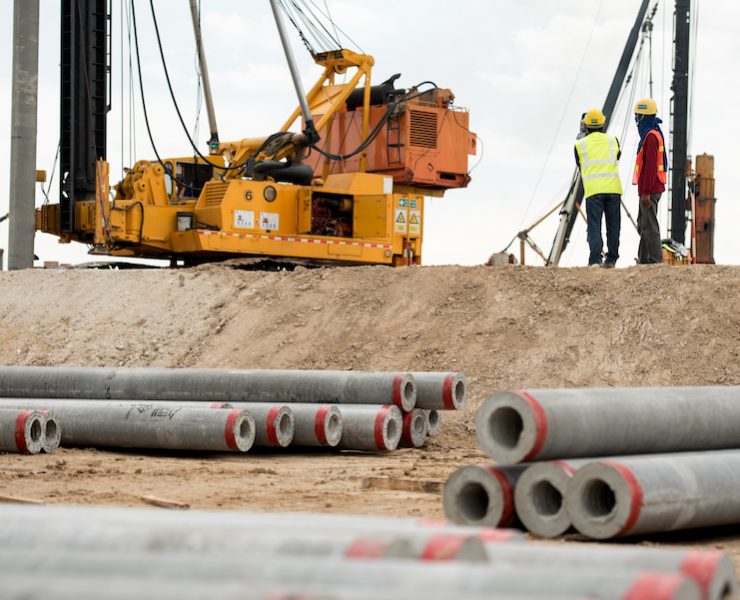The Digital Age, 3d Drawings, And Pile Driving – A New Frontier

It is generally true that with the advent of new technology, business relationships change. Sometimes, that is disruptive of old patterns, and new business patterns emerge that challenge existing ways of doing business, and traditional risk allocations. Such is the case with the electronic drawings – Auto- CAD, and BIM or Building Information Modeling – a fancy, now almost out of date acronym for using 3 dimensional, electronic drawings and models as plans and specs.
For architect and educator Nick Dunn, author of “Digital Fabrication in Architecture”, architectural models ultimately ”enable the designer to investigate, revise and further refine ideas in increasing detail until such a point that the project’s design is sufficiently consolidated to be constructed.” Ok, fair enough, that allows Charles Garry to build the Guggenheim Museum in Bilboa with curved glass shapes. But piling – that does not need fancy models, it’s all still build the same way, right? Who needs models, fancy electronic plans, when in the end, it’s a hammer and a geotech saying “it’s good”?
Let’ not forget, that when the term “piles” were coined centuries ago, they were made of wood, not steel or concrete. Same name, same purpose, new techniques and materials. Here we go again. The advance of digitally driven manufacturing engineering and robotics may soon enough, involve more automated pile rigs, more gizmo’s in the crane cab, and a whole new suite of trainings, and new labor pools integrated into traditional trades.
PREDICTING IMPACT OF NEW TECHNOLOGIES ON THE PILE INDUSTRY
How are these new tools changing the construction landscape? How will this affect the foundation and piling industries?
One, staffing of project teams are more and more going to require tech savvy. On bigger projects, leaders in the digital fabrication world are already complaining about how some project team players do not have the know-how, digital equipment and expertise, or track record to keep up. Digital fidelity – everyone on the same electronic database – will soon exclude players on marquee projects if they do not have all the right bells and whistles.
Two, no matter how sophisticated the tools, it all still comes down to blocking and tackling – or avoiding “Big Dumb Problems” in construction.
Three, just like the advent of the internet has made the world and its communications, “flat”, so also, digital 3D plans erode if not eradicate the traditional “chain of command” of architect talking to owner, owner to prime contractor, prime to subcontractors, and so forth. Instead, all participants lock in to the same set of documents on the project website or BIM. This means subs become integrated into the project design thinking – the more so in mechanical drawing fields on hospitals and high end infrastructure, where the trades have their own engineers and the submittal or shop drawings end up being the ultimate plans.
Four, the expectations in terms of delivery from owners, primes, and end users have climbed high. Some may say it’s because so many end users work behind a desk, and see the virtual perfection of a design on the computer, and assume it can be replicated by the hand of man in the field. Perfection becomes a subliminal standard if the tools create a whole world where the design invariably fits, and there are no soils challenges. Schedules, rapid fire email chains, all risk making speed take over rather than careful planning.
Fifth, digital and electronic communications, for their great convenience, risk the extinction of the formal face to face project meeting. Often these meetings solved real problems in ways letters and emails or phone calls simply cannot.
How will this all affect the Pile Industry? The first question is, who will lead the technology charge, suppliers, pile drivers, or owner engineers? Some engineers are requiring electronic as built drawings of pile layout, using the survey data points and converting them from the computer inside the surveyor’s transit, into a 3D drawing. That is just a start. Who will stamp the pile drawings? Who will be the designer of the pile?
How are new technologies, such as 3D drawings and digital tools, impacting the construction landscape?
New technologies are increasingly requiring tech-savvy staffing on construction projects, changing traditional communication structures, and raising expectations for project delivery.
Who leads the technology adoption in the Pile Industry – suppliers, pile drivers, or owner engineers?
The adoption of technology in the Pile Industry raises questions about leadership, including whether suppliers, pile drivers, or owner engineers will take the lead in incorporating electronic drawings, 3D models, and advanced digital tools.

















